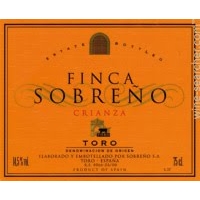
Look down on the gentle hills, Roman bridge, and sprawling vineyards from the hilltop town of Toro and you’ll find yourself thinking, “Really? They can grow good grapes here?” This extreme western portion of the Spanish province of Castilla y Leon is hot, barren, and dry. With summer high temperatures reaching 100 degrees and only 14 inches of rain annually, it’s very nearly desert. And, the high altitude (most vineyards sit at 2,000-2,500 feet above sea level) means that even summer nights get cool and that winters are bitter with mid-winter lows in the teens.
And yet, wine grapes have been grown here for 1,000 years or so. With so little rainfall, early farmers adopted a strategy of planting their vines far apart – as much as 10 feet in all directions can separate vines in the stoniest soils. With these ultra-low densities, each grape vine can spread its roots broadly and deeply to capture the all too scarce rainfall.
Tempranillo for Toro. Over the centuries, a new mutation of Spain’s Tempranillo grape emerged, one that was best able to handle the extreme temperatures and dry conditions. The locals called it “Tinta de Toro,” and it remains the best red wine grape in the region today.
Ample sunshine and hot days Tinta de Toro to ripen to powerful levels, but the cool nights “fix” color and the bright acidity needed to balance massive fruit levels. By medieval times, Toro reds were some of Spain’s most famous, but the region faded from attention with the rise of Rioja (located closer to the all important rail line to Bordeaux) in the 1800s. By the mid-1990s, only 6 wineries remained in operation here, all producing ripe but rustic reds for bulk sales or local consumption.
A Toro Revival. Today there are more than 50 commercial wineries in Toro, and Finca Sobreño’s success is a big reason why. In the mid-1990s, current manager Roberto San Ildefonso and a group of Rioja winemakers created the Bodega to take advantage of the hundreds of acres of old-vine Tempranillo remaining in the region. They build one of the first modern wineries in the region, purchased 200 acres of prime vineyard and eventually locked up access to another 400 acres of old vines as well.
Over the past 20 years, Roberto San Ildefonso and his daughter, Paloma, have established Finca Sobreño as one of Toro’s most outstanding wineries. By the 2006 harvest, Wine Advocate already recognized Finca Sobreño as “an annual fixture in these pages for its superb value,” and wine writer Anthony Dias Blue was calling it “One of best new estates in Toro.”
I’ve admired Finca Sobreño for everyday value for years, but my visit to the winery two summers ago to taste the new releases was an eye-opener. Significant investments in farming and winemaking have taken quality here to new heights. The wines are as ripe, powerful, and explosive as ever, but there’s a new sophistication to the textures and better integration of oak. But – with a little help from importer Fran Kysela – the prices are the best they’ve been in years!

